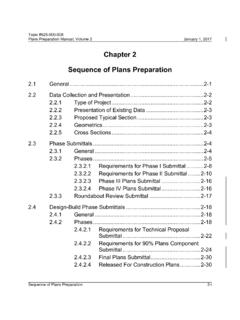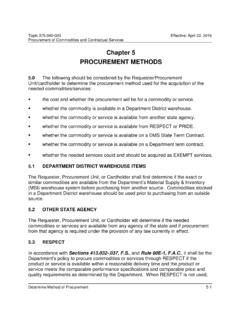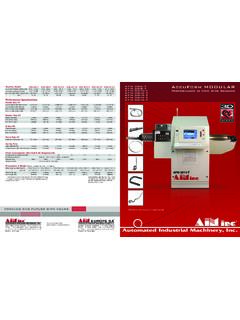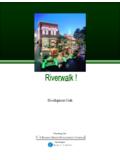Transcription of FDOT Context Classification
1 FDOTC ontextClassificationAugust 2017 The Florida Department of Transportation Complete StreetsHandbookThe Florida Department of Transportation Complete StreetsHandbook1 fdot will routinely plan, design, construct, reconstruct and operate a Context -sensitive system of Complete Streets. To this end, a Context Classification system comprising eight Context classifications has been adopted. The Context Classification of a roadway, together with its transportation characteristics, will provide information about who the users are along the roadway, the regional and local travel demand of the roadway, and fdot Context ClassificationFIGURE 1 Context Classification AND TRANSPORTATION CHARACTERISTICS the challenges and opportunities of each roadway user (see Figure 1).
2 The Context Classification and transportation characteristics of a roadway will determine key design criteria for all non-limited-access state document describes the measures to be used to determine the Context Classification of a roadway. Roadway Users Regional and Local Travel Demand Challenges and Opportunities of Each Roadway UserContext ClassificationTransportation Characteristics2 fdot Context ClassificationFIGURE 2 fdot Context CLASSIFICATIONSC1-Natural Lands preserved in a natural or wilderness condition, including lands unsuitable for settlement due to natural Sparsely settled lands; may include agricultural land, grassland, woodland, and Town Small concentrations of developed areas immediately surrounded by rural and natural areas.
3 Includes many historic Residential Mostly residential uses within large blocks and a disconnected or sparse roadway CLASSIFICATIONThe Context Classification system broadly identifies the various built environments existing in Florida, as illustrated in Figure 2. State roadways will extend through a variety of Context classifications. Figure 2 should not be taken literally to imply all roadways will have every Context Classification or that Context classifications occur in the sequence shown. fdot s Context Classification system describes the general characteristics of the land use, development patterns, and roadway connectivity along a roadway, providing cues as to the types of uses and user groups that will likely utilize the roadway.
4 The Context Classification of a roadway will inform fdot s planning, PD&E, design, construction, and maintenance approaches to ensure that state roadways are supportive of safe and comfortable travel for their anticipated users. Identifying the Context Classification is a step in planning and design, as different Context classifications will have different design criteria and standards. The use of Context classifications to determine criteria for roadway design elements is consistent with national best practices and direction, including the National Cooperative Highway Research Program 3 fdot Context ClassificationC3C-Suburban Commercial Mostly non-residential uses with large building footprints and large parking lots within large blocks and a disconnected or sparse roadway General Mix of uses set within small blocks with a well-connected roadway network.
5 May extend long distances. The roadway network usually connects to residential neighborhoods immediately along the corridor or behind the uses fronting the Center Mix of uses set within small blocks with a well-connected roadway network. Typically concentrated around a few blocks and identified as part of a civic or economic center of a community, town, or Core Areas with the highest densities and building heights, and within fdot classified Large Urbanized Areas (population >1,000,000). Many are regional centers and destinations.
6 Buildings have mixed uses, are built up to the roadway, and are within a well-connected roadway network.(NCHRP) that informs Federal Highway Administration (FHWA) and American Association of State Highway Transportation Officials (AASHTO) guidance. NCHRP Report 855: An Expanded Functional Classification System for Highways and Streets proposes a similar Context -based approach to design that incorporates Context , user needs, and transportation functions into the design process. This research was born out of a need to better define contexts beyond urban and rural classifications, and to incorporate multimodal needs into the existing functional Classification document outlines the steps to determine a roadway s Context Classification .
7 Measures used to determine the Context Classification are presented, and a process to define the Context Classification is outlined for: All projects on existing roadways and for projects that propose new roadways and are in the PD&E or design phases Projects evaluating new roadways in the planning and ETDM screening phases4 fdot Context ClassificationContext Classification (1) Distinguishing Characteristics(2) Primary Measures (3)
8 Secondary Measures Land UseBuilding HeightBuilding PlacementFronting UsesLocation of Off-street ParkingRoadway ConnectivityAllowed Residential Density Allowed Office/ Retail DensityPopulation DensityEmployment DensityIntersection DensityBlock PerimetersBlock Length DescriptionFloor LevelsDescriptionYes / N oDescriptionIntersections/ Square MileFeetFeetDwelling Units/Acre Floor-Area Ratio (FAR)Persons/AcreJobs/AcreC1-NaturalLand s preserved in a natural or wilderness condition, including lands unsuitable for settlement due to natural Land, Open Space, or ParkN/AN/AN/AN/AN/AN/AN/AN/AN/AN/AN/AC2- RuralSparsely settled lands; may include agricultural land, grassland, woodland, and or Single-Family Residential1 to 2 Detached buildings with no consistent pattern of setbacksNoN/A<20N/AN/A<1N/A<2N/AC2T-Rura l TownSmall concentrations of developed areas immediately surrounded by rural and natural areas.
9 Includes many historic , Office, Single-Family or Multi-Family Residential, Institutional, or Industrial1 to 2 Both detached and attached buildings with no or shallow (<20 ) front setbacksYesMostly on side or rear; occasionally in front>100<3,000<500>4> >2C3R-Suburban ResidentialMostly residential uses within large blocks and a disconnected or sparse roadway or Multi-Family Residential1 to 2, with some 3 Detached buildings with medium (20 to 75 ) front setbacksNoMostly in front; occasionally in rear or side<100N/AN/A1 to 8N/AN/AN/AC3C-Suburban CommercialMostly non-residential uses with large building footprints and large parking lots within large blocks and a disconnected or sparse roadway , Office, Multi-Family Residential, Institutional, or Industrial1 (retail uses) and 1 to 4 (office uses)Detached buildings with large (>75') setbacks on all sidesNoMostly in front.
10 Occasionally in rear or side<100>3,000>660N/A< GeneralMix of uses set within small blocks with a well-connected roadway network. May extend long distances. The roadway network usually connects to residential neighborhoods immediately along the corridor or behind the uses fronting the or Multi-Family Residential, Institutional, Neighborhood Scale Retail, or Office1 to 3, with some taller buildingsBoth detached and attached buildings with no setbacks or up to medium (<75 ) front setbacks YesMostly on side or rear; occasionally in front>100<3,000<500>4N/A>5>5C5-Urban CenterMix of uses set within small blocks with a well-connected roadway network.













